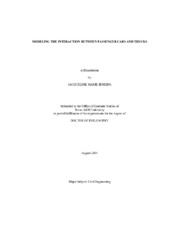| dc.contributor.advisor | Rilett, Laurence R. | |
| dc.creator | Jenkins, Jacqueline Marie | |
| dc.date.accessioned | 2004-11-15T19:54:18Z | |
| dc.date.available | 2004-11-15T19:54:18Z | |
| dc.date.created | 2004-08 | |
| dc.date.issued | 2004-11-15 | |
| dc.identifier.uri | https://hdl.handle.net/1969.1/1296 | |
| dc.description.abstract | The topic of this dissertation was the use of distributed computing to improve the modeling of the interaction between passenger cars and trucks. The two main focus areas were the development of a methodology to combine microscopic traffic simulation programs with driving simulator programs, and the application of a prototype distributed traffic simulation to study the impact of the length of an impeding vehicle on passing behavior.
The methodology was motivated by the need to provide an easier way to create calibrated traffic flows in driving simulations and to capture vehicle behavior within microscopic traffic simulations. The original design for the prototype was to establish a two-way, real time exchange of vehicle data, however problems were encountered that imposed limitations on its development and use.
The passing study was motivated by the possible changes in federal truck size and weight regulations and the current inconsistency between the passing sight distance criteria for the design of two lane highways and the marking of no-passing zones. Test drivers made passing maneuvers around impeding vehicles that differed in length and speed. The main effects of the impeding vehicle length were found to be significant for the time and distance in the left lane, and the start and end gap distances.
Passing equations were formulated based on the mechanics of the passing maneuver and included behavior variables for calibration. Through a sensitivity analysis, it was shown that increases in vehicle speeds, vehicle length, and gap distance increased the distance traveled in the left lane, while increases in the speed difference and speed gain decreased the distance traveled in the left lane. The passing equations were calibrated using the current AASHTO values and used to predict the impact of increased vehicle lengths on the time and distance in the left lane. The passing equations are valuable for evaluating passing sight distance criteria and observed passing behavior. | en |
| dc.format.extent | 4829518 bytes | en |
| dc.format.extent | 454306 bytes | en |
| dc.format.medium | electronic | en |
| dc.format.mimetype | application/pdf | |
| dc.format.mimetype | text/plain | |
| dc.language.iso | en_US | |
| dc.publisher | Texas A&M University | |
| dc.subject | traffic simulation | en |
| dc.subject | driving simulation | en |
| dc.subject | distributed simulation | en |
| dc.subject | passing maneuver | en |
| dc.subject | passing behavior | en |
| dc.title | Modeling the interaction between passenger cars and trucks | en |
| dc.type | Book | en |
| dc.type | Thesis | en |
| thesis.degree.department | Civil Engineering | en |
| thesis.degree.discipline | Civil Engineering | en |
| thesis.degree.grantor | Texas A&M University | en |
| thesis.degree.name | Doctor of Philosophy | en |
| thesis.degree.level | Doctoral | en |
| dc.contributor.committeeMember | Spiegelman, Cliff H. | |
| dc.contributor.committeeMember | Burris, Mark W. | |
| dc.contributor.committeeMember | Koppa, Rodger J. | |
| dc.type.genre | Electronic Dissertation | en |
| dc.type.material | text | en |
| dc.format.digitalOrigin | born digital | en |


